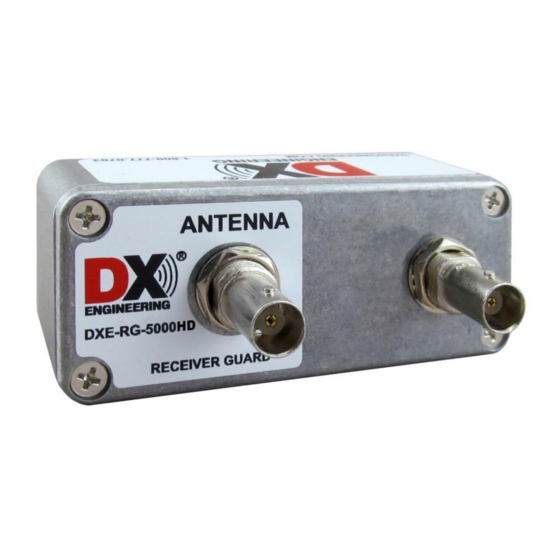Table of Contents
Advertisement
Quick Links
Receiver Guard 5000HD
Receiver Front-End Protector
DXE-RG-5000HD
DXE-RG-5000-INS Rev 2
© DX Engineering 2019
DX Engineering - 1200 Southeast Ave. - Tallmadge, OH 44278 USA
Phone: (800) 777-0703 ∙ Tech Support and International: (330) 572-3200
Fax: (330) 572-3279 ∙ E-mail:
DXEngineering@DXEngineering.com
Advertisement
Table of Contents

Summary of Contents for DX Engineering DXE-RG-5000HD
- Page 1 Receiver Guard 5000HD Receiver Front-End Protector DXE-RG-5000HD DXE-RG-5000-INS Rev 2 © DX Engineering 2019 DX Engineering - 1200 Southeast Ave. - Tallmadge, OH 44278 USA Phone: (800) 777-0703 ∙ Tech Support and International: (330) 572-3200 Fax: (330) 572-3279 ∙ E-mail: DXEngineering@DXEngineering.com...
-
Page 2: Introduction And General Information
S-9, which is only 25 mw. That level is well under the point of front end damage. When there are high levels of RF on your receive antennas, DX Engineering’s Receiver Guards generate far less harmonic noise than other limiters on the market, which allows your station to continue to operate safely and competitively. - Page 3 DC. If you are using the Receiver Guard in a system that requires a DC voltage, insert the DC as shown in Figure 7. This is a Receive Only Accessory Do not connect the DXE-RG-5000HD Receiver Guard to a transmitter output DO NOT TRANSMIT through the Receiver Guard The Receiver Guard is is NOT a filter.
- Page 4 What happens if the receive antenna is extremely close to the transmit antenna, or there is an antenna support or other system failure that causes a high RF level to enter the receive antenna input? The DX Engineering Receiver Guard can save the day! Some Amateur Radio Operators have an antenna installation arrangement where their Beverage wire antenna, or other receive antenna, is installed in close proximity to the transmit antenna.
-
Page 5: Installation
Installation The DXE-RG-5000HD Receiver Guard is intended to be installed indoors, at the radio. The following pages show various setups using the Receiver Guard. There are many more combinations possible beyond these basic diagrams. - Page 6 Figure 2 - Basic Receive Antenna Installation The DX Engineering Receiver Guard is installed between the receive antenna (in this example, the DXE-BFS-1 Beverage Antenna) and the transceiver’s RX ANT IN connection (receive antenna input). On the ICOM IC-7600, press and hold the ANT selector until 1/R is displayed on the screen as the selected antenna.
- Page 7 Figure 5 - Typical Beverage Receive Installation with optional Preamplifier, Lightning Protection and Receive Feedline Current Choke Figure 5 expands the options shown in Figure 5 by including the optional DXE-RFCC-1 Receive Feedline Current Choke installed. Consult your transceiver manual regarding the use of RX OUT and RX IN connections.
- Page 8 Figure 7 - Using the DX Engineering Receiver Guard in an Active Receive System with an Active Receive Antenna and a Transceiver that does not have a Separate Receive Input Figure 7 shows a Transceiver without a RX IN. The DXE RTR provides the required switching needed between the transmit antenna and the DXE-ARAV Active Receive antenna.
- Page 9 Figure 8 - System using a separate Receiver Figure 8 expands further on Figure 7 by using a separate receiver in conjunction with the DXE-RSC-2 2-Port Splitter / Combiner to allow using the receiver. Note the DXE-FVI-1 Voltage Injector must be located inline on the active receive antenna side of the Receiver Guard.
- Page 10 Figure 9 - Classic T/R Relay application used with the DXE-RTR and the DXE-RG-5000HD Figure 9 shows a classic transmitter and receiver combination using the DXE-RTR along with the Ameritron AMR-ARB-704 to provide the switching needed. The DXE-RG-5000HD Receiver Guard is shown in-line with the DXE-RPA Receive Preamplifier.
- Page 11 Figure 10 - Adding the DXE-RG-5000HD Receiver Guard to a transceiver without separate RX input and using one antenna for Transmit and Receive Figure 10 shows the DXE-RG-5000HD Receiver Guard being used with a Kenwood TS-690 system that uses one antenna for both transmit and receive and the transceiver does not have a separate RX IN connection.
-
Page 12: Technical Support
All products manufactured by DX Engineering are warranted to be free from defects in material and workmanship for a period of one (1) year from date of shipment. DX Engineering’s sole obligation under these warranties shall be to issue credit, repair or replace any item or part thereof which is proved to be other than as warranted; no allowance shall be made for any labor charges of Buyer for replacement of parts, adjustment or repairs, or any other work, unless such charges are authorized in advance by DX Engineering.















Need help?
Do you have a question about the DXE-RG-5000HD and is the answer not in the manual?
Questions and answers